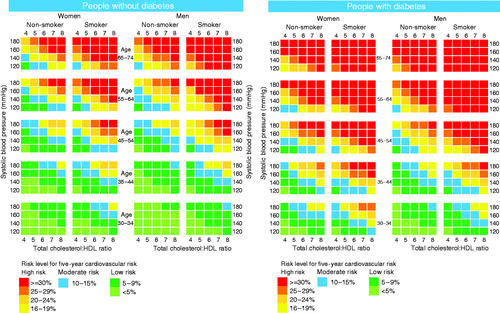
Tools for building simulation models
The studies below provide risk equations for key health state transitions that can be used to build diabetes simulation models. They all report the equations in sufficient detail to enable other researchers to use them in their own models. We would welcome new contributions.
UKPDS risk factor time path equations
The UKPDS group has published risk factor time path equation that can be used in combination with the UKPDS Outcomes Model Version 2.
These represent treatment policies for metabolic risk factors such as systolic blood pressure that were observed during the UKPDS study and in the post-study follow-up period (up until 2002).
The equations can be used to understand the potential benefits from using newer interventions that are better able to control key risk factors.
New Type 1 Diabetes Model
A new patient-level simulation model for predicting lifetime health outcomes of patients with type 1 diabetes and as a tool for economic evaluation of type 1 diabetes treatment based on data from a large, longitudinal cohort has been produced using 27,841 patients with type 1 diabetes with a mean duration of follow-up of 7 years from Swedish Diabetes Registry. The model publications contains all parametric proportional hazards models predicting the absolute risk of diabetes complications and death based on a wide range of clinical variables and history of complications. The publication reporting the model is avaliable as a Open Access pdf (click on the link).
Validation and recalibration of the Framingham cardiovascular disease risk models in an Australian Indigenous cohort
Framingham models were applied to the Well Person’s Health Check (WPHC) cohort (followed 1998–2014), which included 1448 Aboriginal and Torres Strait Islanders from remote Indigenous communities in Far North Queensland. Cardiovascular disease risk predicted by the original and recalibrated Framingham models were compared with the observed risk in the WPHC cohort.
The original Framingham models significantly underestimate the absolute cardiovascular disease risk for this Australian Indigenous population. The recalibrated 2008 Framingham model shows good performance on predicting five-year cardiovascular disease risk in this population and was used to calculate the first risk chart based on empirical validation using long-term follow-up data from a remote Australian Indigenous population.
An Excel based calculator for the 5 year CVD risk equation is available.

How Consistent is the Relationship between Improved Glucose Control and Modelled Health Outcomes for People with Type 2 Diabetes Mellitus? a Systematic Review
The purpose of this study was to evaluate the relationship between improvements in glycosylated haemoglobin (HbA1c) and simulated health outcomes in type 2 diabetes cost-effectiveness studies. A systematic review was conducted on MEDLINE and EMBASE to collect cost-effectiveness studies using type 2 diabetes simulation models that reported modelled health outcomes of blood glucose-related interventions in terms of quality-adjusted life-years (QALYs) or life expectancy (LE). Linear regressions were used to test the relationship between risk factors such as HbA1c and incremental QALYs or LE of intervention and control groups.
The regression equation forms the basis of a QALY calculator that has multiple uses:
First, it can be used as a diagnostic tool or benchmark for decision makers, enabling them to identify analyses that deviate from the general trend and investigate whether there are other factors that may have led to the discrepancy and whether they are reasonable.
Second, with limited information and resources to run a diabetes simulation model, the regression estimated in this study can be used to give a rough prediction of the long-term effectiveness that could be expected from an intervention in its early stages.
An Excel version of the calculator can be obtained here.

Type 2 diabetes - UKPDS Outcome Model
Equations for forecasting the occurrence of seven diabetes-related complications and death for people with Type 2 diabetes were estimated using data on 3642 patients from the United Kingdom Prospective Diabetes Study (UKPDS). The model is able to simulate event histories that closely match observed outcomes in the UKPDS and that can be extrapolated over patients’ lifetimes.

Type 2 diabetes - UKPDS Outcomes model Version 2
Data from 5,102 UKPDS patients from the 20 year trial and the 4,031 survivors entering the 10 year post-trial monitoring period were used to derive parametric proportional hazards models predicting absolute risk of diabetes complications and death. We re-estimated the seven original event equations and estimated new equations for diabetic ulcer and some second events. The additional data permitted inclusion of new risk factor predictors such as estimated GFR. We also developed four new equations for all-cause mortality.

An alternative approach to modelling HbA1c trajectories in patients with type 2 diabetes mellitus.
Time-dependent HbA1c trajectories in health economic models of type 2 diabetes mellitus (T2DM) are typically informed by the UK Prospective Diabetes Study (UKPDS). However, this approach may not accurately predict HbA1c progression in patients who do not conform to the demographic profile of the original UKPDS cohort. This study aimed to develop an alternative mathematical model (MM) to simulate HbA1c progression in T2DM. A systematic literature review identified studies, published between 2005 and 2015, that reported HbA1c in adult T2DM patients over a minimum duration of 18 months. Pooled data from eligible studies were used to develop an alternative MM equation for HbA1c progression, which was then contrasted with the UKPDS 68 regression equation in illustrative scenarios.

Simulating Lifetime Outcomes Associated with Complications for People with Type 1 Diabetes
Synthesizes evidence on type 1 diabetes patients using several published sources. The simulation model was based on 13 equations to estimate risks of events and mortality. Cardiovascular disease (CVD) risk was obtained from results of the DCCT (diabetes control and complications trial). Mortality post-CVD event was based on a study using linked administrative data on people with diabetes from Western Australia. Information on incidence of renal disease and the progression to CVD was obtained from studies in Finland and Italy. Lower-extremity amputation (LEA) risk was based on the type 1 diabetes Swedish inpatient registry, and the risk of blindness was obtained from results of a German-based study.

Predicting mortality in people with Type 2 diabetes mellitus after major complications: a study using Swedish National Diabetes Register data
The study sample, taken from the Swedish National Diabetes Register, consisted of 20 836 people with Type 2 diabetes who had their first major complication (myocardial infarction, stroke, heart failure, amputation or renal failure) between January 2001 and December 2007. A Gompertz proportional hazards model was derived which determined significant risk factors associated with mortality and was used to estimate life expectancies.

Adapting and validating diabetes simulation models across settings: Accounting for mortality differences using administrative data
Develops age and sex-specific risk equations for predicting mortality following major complications
of diabetes, using a large linked administrative dataset from Western Australia (WA) and to incorporate these into an existing diabetes simulation model. It uses linked hospital and mortality records on 13,884 patients following a major diabetes related complication with a mean (SD) duration of 2.62 (2.25) years. Risk equations for predicting mortality were derived and integrated into the UKPDS Outcomes Model.

Simulation of Quality-Adjusted Survival in Chronic Diseases: An Application in Type 2 Diabetes
The authors developed a simulation model of disease progression in type 2 diabetes to investigate the impact of patient quality of life on lifetime outcomes and its potential response to therapy. Changes in health utility over time are captured as a result of complications and aging. All risk equations, model parameter estimates, and input data were derived from patient-level data from the Fenofibrate Intervention and Event Lowering in Diabetes (FIELD) trial.

Towards Renewed Health Economic Simulation of Type 2 Diabetes: Risk Equations for First and Second Cardiovascular Events from Swedish Register Data
The study aims to predict the risk of developing first and second acute myocardial infarction, heart failure, non-acute ischaemic heart disease, and stroke after diagnosis in patients with type 2 diabetes, using data from the Swedish National Diabetes Register.
Register data on 29,034 patients with type 2 diabetes were analysed over five years of follow up (baseline 2003). To develop and validate the risk equations, the sample was randomly divided into training (75%) and test (25%) subsamples. The Weibull proportional hazard model was used to estimate the coefficients of the risk equations, and these were validated in both the training and the test samples.

Multivaraite Prediction Equations for HbA1c Lowering, Weight Change, and Hypoglycemic Events Associated with Insulin Rescue Medication in Type 2 Diabetes Mellitus: Informing Economic Modeling.
Clinical evidence for insulin use in T2DM was identified in PubMed and from published reviews and meta-analyses. Study and patient characteristics and treatment effects and adverse event rates were extracted and the data used to estimate parsimonious treatment effect and hypoglycemic event risk equations using multivariate regression analysis.




